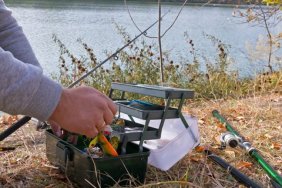 It’s happened to everyone at least once. We fight a fish for several minutes, only to lose it for some reason. Then we reel in the line and discover that the lure is gone and all that remains is a twisted, coiled mess at the end of the line. This is due to bad knot tying or using the wrong knot completely. Believe it or not, there are some anglers who use one knot for all line types and all connections. While they may get away with it the majority of the time, using the wrong knot for the wrong line type can put stress on the line, which weakens it drastically, and will eventually cost them a big fish. While I wish I could provide you all with step-by-step, visual guides for every knot, I’ll do the next best thing and provide you with an outline of some popular knots and what they’re primarily used for, so you’ll never run the risk of losing a fish because of something as simple as a knot ever again.
It’s happened to everyone at least once. We fight a fish for several minutes, only to lose it for some reason. Then we reel in the line and discover that the lure is gone and all that remains is a twisted, coiled mess at the end of the line. This is due to bad knot tying or using the wrong knot completely. Believe it or not, there are some anglers who use one knot for all line types and all connections. While they may get away with it the majority of the time, using the wrong knot for the wrong line type can put stress on the line, which weakens it drastically, and will eventually cost them a big fish. While I wish I could provide you all with step-by-step, visual guides for every knot, I’ll do the next best thing and provide you with an outline of some popular knots and what they’re primarily used for, so you’ll never run the risk of losing a fish because of something as simple as a knot ever again.
The first thing to understand is that there are different knots for different uses. Whether it’s simply attaching line to a spool, joining two lines together, or securing line to a lure, choosing the right knot for each is important.
When joining two lines together, such as leader material or backing, there are several options from which to choose. For two different line types, an Albright, a slim beauty, or double uni know are optimal. A Seaguar knot works well when fastening fluorocarbon to monofilament. Fly anglers will want to use a nail knot to attach their fly line to the leader. For other line-to-line connections, the blood knot or the surgeon’s knot will do fine.
Loops are sometimes called for in fishing situations, and there are a few knots that accomplish this, based on what you need. Trolling anglers will want to try a Bimini twist knot, for example. For anglers looking to create loops along their line, for numerous hooks, for example, a dropper loop works very well. Loops are great for allowing lures to work without a knot directly attached to the lure eye, also. A Surgeon’s End loop, Rapala knot, and a perfection loop are good choices here, as is the Kreh loop.
For simple, hook or lure connections, there are several knots from which to choose. The improved clinch, eye crosser, San Diego jam, snell, Trilene, uni, and World’s Fair are all great knots in this situation. For braided line, I always use a Palomar knot, which is very strong and easy to tie. Heavier line might require a Baja knot, which is designed for it.
The key to learning knots is to practice tying them often. To learn how to do this, there are several good books and websites that offer step-by-step guides. Furthermore, any experienced associate at an outdoor retail store should be able to show you how to tie a number of knots. The average angler will only need a handful of the knots listed above, but being able to adapt and tie the right knot for any situation will go a long way towards ensuring you don’t lose a fish to the wrong knot in the future.








